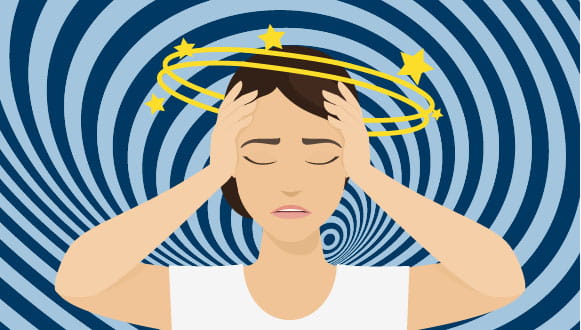Vertigo: Symptoms, Causes, Treatment
What are the symptoms of vertigo?
Vertigo is a type of dizziness characterized by a sensation of spinning or whirling, even when you are stationary. It is often caused by problems in the inner ear or the balance centers of the brain. Symptoms of vertigo can include:
- A spinning sensation: This is the hallmark symptom of vertigo. It may feel like you or your surroundings are spinning or moving when they are not.
- Nausea and vomiting: The sensation of spinning can lead to nausea, and in some cases, vomiting.
- Loss of balance or unsteadiness: Vertigo can make you feel unsteady on your feet or like you are going to fall.
- Difficulty standing or walking: The spinning sensation of vertigo can make it difficult to stand or walk without assistance.
- Nystagmus: This is a rapid, involuntary movement of the eyes that can occur with vertigo.
- Sweating: Some people with vertigo may experience sweating, especially during episodes of vertigo.
- Headaches: Headaches, particularly migraines, can be associated with vertigo.
- Tinnitus: Some people with vertigo may experience ringing in the ears.
- Hearing loss: In some cases, vertigo may be accompanied by hearing loss.
Symptoms of vertigo can range from mild to severe and may come and go. They can be triggered by changes in head position, such as turning over in bed or looking up, or by certain movements, such as standing up quickly. If you experience symptoms of vertigo, especially if they are severe or recurrent, it’s important to see a healthcare provider for an accurate diagnosis and appropriate treatment.
What are the causes of vertigo?
Vertigo can be caused by various underlying conditions that affect the inner ear or the balance centers of the brain. Some common causes of vertigo include:
- Benign paroxysmal positional vertigo (BPPV): This is one of the most common causes of vertigo and is caused by small calcium crystals in the inner ear that become dislodged and float in the fluid-filled canals, affecting balance.
- Meniere’s disease: This is a disorder of the inner ear that causes episodes of vertigo, hearing loss, tinnitus (ringing in the ears), and a feeling of fullness or pressure in the ear.
- Vestibular neuritis: This is an inflammation of the vestibular nerve, which connects the inner ear to the brain and is responsible for sending balance signals. It can cause sudden, severe vertigo that may be accompanied by nausea and vomiting.
- Labyrinthitis: This is an inflammation of the labyrinth, a structure in the inner ear that helps control balance. It can cause vertigo, hearing loss, and tinnitus.
- Migraine-associated vertigo: Some people who experience migraines may also experience vertigo as a symptom of their migraine attacks.
- Head injury: A head injury or trauma can damage the inner ear or the balance centers of the brain, leading to vertigo.
- Acoustic neuroma: This is a noncancerous tumor that grows on the vestibular nerve or the nerve that connects the inner ear to the brain. It can cause vertigo, hearing loss, and tinnitus.
- Medications: Certain medications, such as some antibiotics, antidepressants, and anti-seizure medications, can cause vertigo as a side effect.
- Other conditions: Vertigo can also be caused by conditions such as stroke, multiple sclerosis, and anxiety disorders.
The specific cause of vertigo can vary from person to person, so it’s important to see a healthcare provider for an accurate diagnosis and appropriate treatment. Treatment for vertigo depends on the underlying cause and may include medications, physical therapy, or other interventions.
What is the treatment for vertigo?
The treatment for vertigo depends on the underlying cause of the condition. Some common treatments for vertigo include:
- Epley maneuver: This is a series of head movements that can help move the calcium crystals in the inner ear that cause benign paroxysmal positional vertigo (BPPV) back into the correct position.
- Vestibular rehabilitation: This is a type of physical therapy that focuses on exercises and activities to improve balance and reduce dizziness.
- Medications: Depending on the underlying cause of vertigo, medications such as antihistamines, anti-nausea medications, or vestibular suppressants may be prescribed to help manage symptoms.
- Treatment of underlying conditions: If vertigo is caused by an underlying condition, such as Meniere’s disease or vestibular neuritis, treatment will focus on managing that condition. This may include medications, dietary changes, or other interventions.
- Surgery: In some cases, surgery may be recommended to treat certain causes of vertigo, such as acoustic neuroma.
- Lifestyle changes: Making certain lifestyle changes, such avoiding alcohol, caffeine, and tobacco, and getting regular exercise, can help reduce the frequency and severity of vertigo episodes.
- Home remedies: Some people find relief from vertigo symptoms by using home remedies such as ginger, which may help reduce nausea associated with vertigo.
It’s important to see a healthcare provider for an accurate diagnosis and appropriate treatment if you experience vertigo. In some cases, vertigo can be a symptom of a more serious underlying condition, so prompt medical attention is important.




